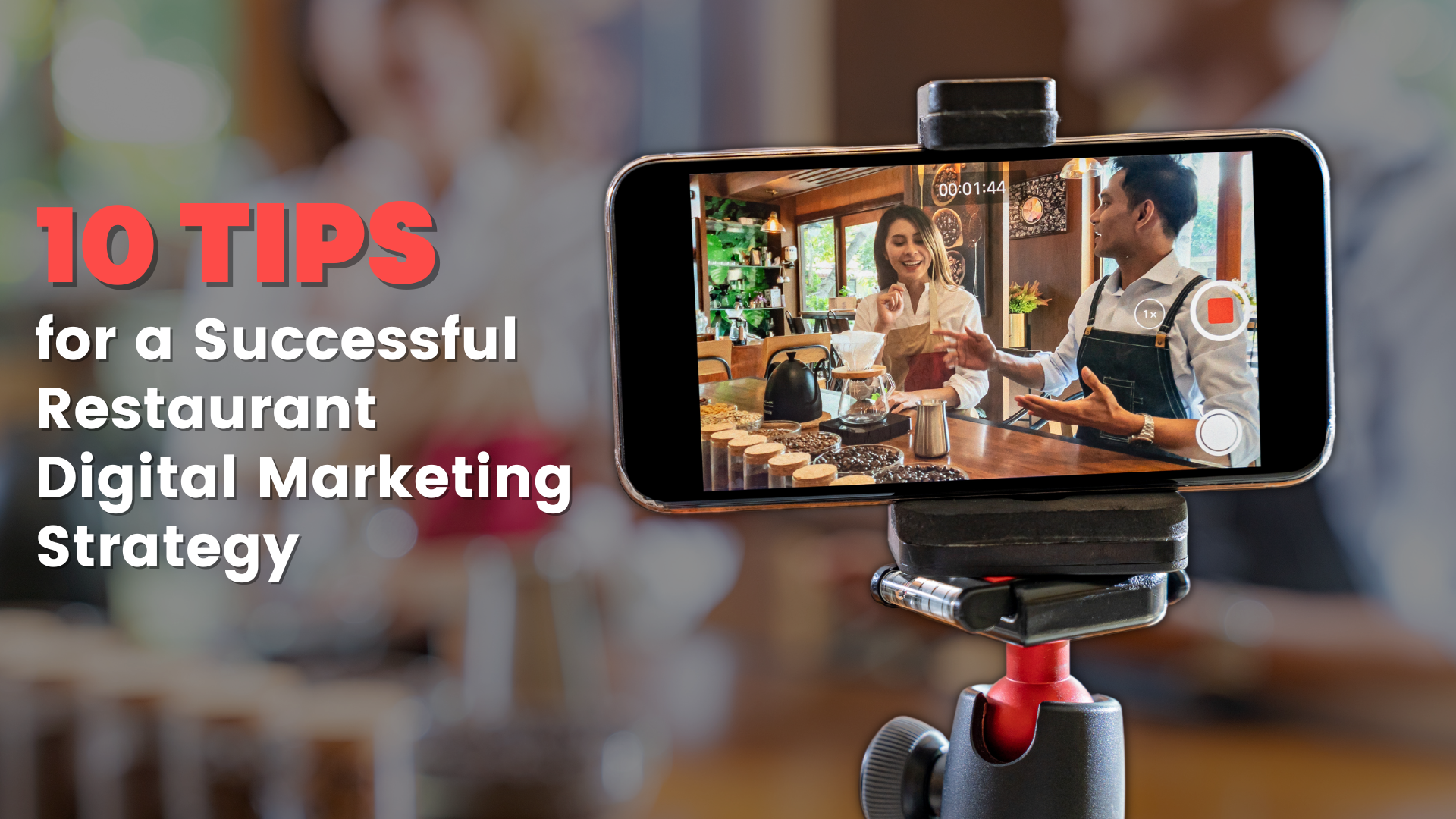A successful restaurant digital marketing strategy is essential for any restaurant that wants to thrive in today’s competitive business world. With an ever-growing online presence, restaurants need to be able to capitalise on the various digital marketing opportunities available to them. From SEO optimization to social media marketing, there are many tools available to help restaurants reach their target audience. In this article, we’ll share our top 10 tips for a successful restaurant digital marketing strategy.
#1: Develop a Comprehensive Digital Marketing Plan
Creating a comprehensive digital marketing plan is essential for any restaurant looking to succeed in the digital space. It’s important to start by setting goals, such as increasing brand awareness, driving more website traffic, or boosting sales. Once you have established your goals, you can begin to develop a plan that outlines the steps you need to take in order to reach them.
When creating a digital marketing plan, it’s important to consider all of your channels, such as your website, email marketing, and social media. You should also think about what type of content you’ll be producing, such as blog posts, videos, and infographics. Additionally, you should determine how often you’ll be posting or sending out emails, as well as the budget that you’ll be allocating for each channel. Finally, you should consider any additional tactics you’ll be using, such as SEO, PPC, or influencer marketing.
#2: Utilise Social Media Platforms
Social media platforms are a powerful tool for restaurants to connect with their customers. With over three billion users worldwide, social media platforms are a great way for restaurants to reach potential customers and engage with existing customers. By creating engaging posts and content, restaurants can build awareness of their brand, keep customers informed about new menu items, and increase customer loyalty. Additionally, social media platforms offer a great opportunity to interact with customers. By responding to comments, questions, and reviews, restaurants can demonstrate their commitment to customer service and build relationships with customers. Restaurants can also use social media to host giveaways and promotions, allowing customers to feel appreciated and rewarded.
#3: Create a Mobile-Friendly Website
It’s important to ensure that your customers are able to easily find your website and access it from any device and any platform. With the increasing prevalence of smartphones and tablets, it has become essential for restaurants to create a website that is optimised for mobile devices. This means that not only should your website be easy to navigate, but it should also be designed to be fully responsive, meaning that it adjusts to fit the screen size of any device. Additionally, it’s important to make sure that the content on your website is optimised for mobile devices and loads quickly, as customers may be accessing your website while on the go. Having a mobile-friendly website helps to build customer loyalty, as it allows customers to easily access your website, services, and information. This also helps to increase your business’s online visibility, as mobile-friendly websites are likely to rank higher in search engine results. Finally, a mobile-friendly website helps to provide a better overall customer experience, as it allows customers to easily access the information they need without having to navigate a desktop version of your website.
#4: Leverage Email Marketing
By leveraging email marketing, restaurants can reach their customers directly and quickly. With email campaigns, restaurants can create personalised content to their customers, allowing them to stay connected with their customers and build relationships. Restaurants can also use email campaigns to promote special offers, discounts, and loyalty programs. This helps to encourage customers to return to the restaurant and helps to build customer loyalty. Additionally, email campaigns help to increase brand awareness and keep customers informed of any new promotions or menu items.
Restaurants should also ensure that their emails are properly optimised for mobile devices. This will ensure that customers can easily access the content and act on the email. Restaurants should also ensure that their emails are engaging, including visuals and clear CTAs. This will help to increase the click-through rates of the emails, resulting in more customers engaging with the restaurant.
#5: Invest in Paid Advertising
With paid advertising, you can reach a larger audience and target customers more precisely. Paid ads can be run on platforms such as Google Ads, Bing Ads, social media, and other websites. With these platforms, you can create tailored ads that target customers based on their interests, location, and other demographics. This can help you reach the right customers and draw them to your restaurant. Paid advertising also allows you to track your results, so you can see which of your ads are working and which ones need to be improved. With this data, you can optimise your ads to ensure they’re reaching the right people and delivering the best possible results. Additionally, you can use this data to adjust your budget and focus on the ads that are working best for you.
#6: Optimise Your Website for Search Engines
Search engine optimization, or SEO, is the practice of optimising a website to rank higher in search engine results pages. With the right optimization tactics, a restaurant can increase its visibility and drive more customers to its website. One of the most important aspects of SEO is keyword research. The goal of keyword research is to identify high-volume, relevant keywords that are being searched for by potential customers. Once these keywords have been identified, they should be incorporated into the website content in order to ensure that search engines can easily find and index the website. Additionally, the website should be optimised for mobile devices, as this will help increase its visibility in search engine results.
Finally, it is important to ensure that the website is optimised for local search. This means that the website should include local keywords, such as the restaurant’s city or neighborhood, in order to ensure that it appears in local search results. Additionally, a restaurant can submit their website to local directories, such as Yelp or Google My Business, in order to further increase their visibility in local search results. By taking these steps, a restaurant can ensure that their website will be easily found by potential customers and drive more traffic to their website.
#7: Incorporate Video Content
In the age of digital marketing, video content is becoming increasingly important for businesses to incorporate into their strategy. A restaurant digital marketing strategy should include video content to help engage customers and draw in more business. Videos of the restaurant’s atmosphere, food, and staff can help make a great first impression and help potential customers decide to visit. Additionally, videos can help build relationships with customers by showcasing the restaurant’s personality, while also highlighting special offers or events.
Videos should be shared across multiple platforms, such as a website, YouTube, and social media. This can help to spread the message further and attract more people to the restaurant. Videos should be concise, entertaining, and informative in order to grab viewers’ attention. Additionally, videos should also be optimised for search engines to ensure that the content is seen by the right people. Finally, it is important to measure the success of the videos, so that changes can be made to the content if needed. By following these steps, restaurants can successfully incorporate video content into their digital marketing strategy.
#8: Utilise Influencer Marketing
Influencers are people with large online followings who are considered experts in their industry. When a restaurant works with an influencer, they benefit from the influencer’s audience and reputation. For example, an influencer might post a photo of a dish from the restaurant on their social media page, which can result in an increase in followers and customers. When using influencer marketing, it’s important to choose influencers who have a large, relevant following. For example, if a restaurant specialises in Italian cuisine, they should look for influencers who focus on Italian food.
Additionally, restaurants should make sure the influencers they work with are authentic and have a genuine interest in the restaurant’s offerings. This will help ensure that the influencer’s post will be seen as genuine and not just an advertisement. Finally, it’s important for restaurants to provide influencers with clear instructions on how to promote their brand. This can include specific hashtags, links to the restaurant’s website, or even a coupon code for followers to receive a discount. With the right influencer marketing strategy in place, restaurants can benefit from increased online visibility and potentially increased sales.
#9: Monitor and Analyse Your Results
It is important to track the progress of your campaigns and adjust them accordingly to maximise their effectiveness. This involves setting measurable goals and tracking the performance of your campaigns. You can use various tools such as Google Analytics and Facebook Insights to measure the success of your campaigns. It is also important to analyse the data from your campaigns to identify any areas of improvement. This can include understanding which campaigns are producing the most conversions, which campaigns are driving more traffic to your website, and which campaigns are generating the highest return on investment. By understanding the data, you can make informed decisions about which campaigns to focus on and which to abandon.
#10: Keep Up with Trends
When it comes to restaurant digital marketing, it is important to stay on top of the latest trends. Trends can be anything from food production to menu items to marketing techniques. Keeping up with trends can help restaurants stay ahead of their competition and bring in more customers. One way to stay on top of trends is to follow digital marketing influencers and other industry experts. Following industry experts can help you stay up to date on the latest trends and techniques that can help you improve your restaurant’s digital marketing strategy. You can also join industry groups and forums to stay informed of the latest industry news.
Another way to keep up with trends is to analyse the competition. It can be helpful to look at what other restaurants in your area are doing and see if there are any trends they are using that you could adopt. You can also look at what is working for other restaurants and use that to create your own digital marketing strategy.
Conclusion
In conclusion, digital marketing strategies for restaurants are essential for success in today’s competitive market. By following the 10 tips outlined in this blog post, restaurants can create and implement an effective digital marketing strategy that will increase their reach, engage customers, and ultimately increase their profits.




